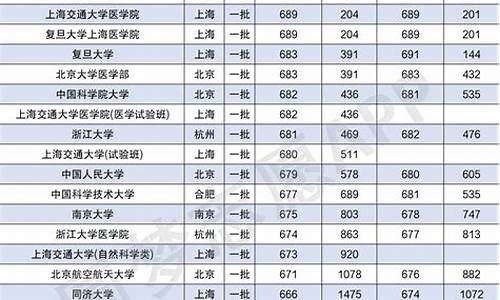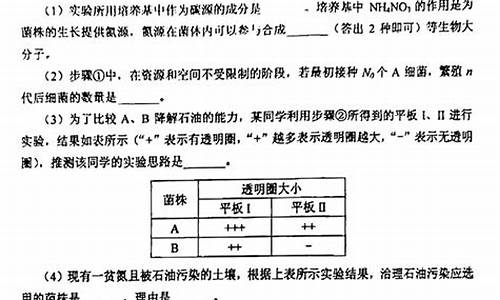您现在的位置是: 首页 > 热门专业 热门专业
甘肃2017高考英语答案_甘肃2017高考英语答案
tamoadmin 2024-05-19 人已围观
简介1 不定式作宾语 1) 动词+ 不定式 afford, aim, appear, agree, arrange, ask, be, decide, bother, care, choose, come, dare, demand, desire, determine, expect, elect, endeavor, hope, fail, happen, help, hesitate, lea

1 不定式作宾语
1) 动词+ 不定式
afford, aim, appear, agree, arrange, ask, be, decide, bother, care, choose, come, dare, demand, desire, determine, expect, elect, endeavor, hope, fail, happen, help, hesitate, learn, long, mean, manage, offer, ought, plan, prepare, pretend, promise, refuse, seem, tend, wait, wish, undertake
The driver failed to see the other car in time. 司机没能及时看见另一辆车。
I happen to know the answer to your question. 我碰巧知道你那道问题的答案。
2) 动词+不定式;动词+宾语+不定式
ask, beg, choose, expect, hate, help intend like, love, need prefer, prepare, promise, want, wish
I like to keep everything tidy. 我喜欢每件东西都保持整洁。
I like you to keep everything tidy. 我喜欢你使每件东西都保持整洁。
I want to speak to Tom. 我想和汤姆谈话。
I want you to speak to Tom. 我想让你和汤姆谈话。
3) 动词+疑问词+ to
decide, know, consider forget, learn, remember, show, understand, see, wonder, hear, find out, explain, tell
Please show us how to do that. 请演示给我们如何去做。
There are so many kinds of tape-recorders on sale that I can't make up my mind which to buy.有这么多的录音机,我都拿不定主意买哪一种。
注意
疑问词带不定式在句中作成分时,谓语动词用单数。如:The question is how to put it into practice. 问题是怎样把它付诸实施。
2. 不定式作补语
1) 动词+宾语+不定式(to do)
advise, allow, appoint, believe, cause, challenge, command, compel, consider, declare, drive, enable, encourage, find, forbid, force, guess, hire, imagine, impel, induce, inform, instruct, invite, judge, know, like, order, permit, persuade, remind, report, request, require, select, send, state, suppose, tell, think, train, trust, understand, urge, warn
a.Father will not allow us to play on the street. 父亲不让我们在街上玩耍。
b.We believe him to be guilty. 我们相信他是有罪的。
Find 的特殊用法
Find 后可用分词做宾补,或先加形式宾语,再加形容词,最后加带to 的动词不定式。find后也可带一个从句。此类动词还有get,have。
I found him lying on the ground.
I found it important to learn.
I found that to learn English is important.
典型例题
The next morning she found the man ___ in bed,dead.
A. lying B. lie C. lay D. laying
答案:A.find的宾语后面,用分词或分词短语,起宾语补足语作用。现在分词表达主动,也表达正在进行,过去分词表达被动。
2) to + be 的不定式结构,作补语的动词。
acknowledge, believe, consider, think, declare(声称), discover, fancy(设想), feel, find, guess, judge, imagine, know, prove, see(理解), show, suppose, take(以为), understand
We consider Tom to be one of the best students in our class. 我们认为汤姆是班上的学生之一。
典型例题
Charles Babbage is generally considered ___ the first computer.
A. to invent B. inventing C. to have invented D. having invented
答案:A. 由consider to do sth. 排除B、D。. 此句只说明发明这一个事实,不定式后用原形即可。而C为现在完成时,发明为点动词一般不用完成时,且此处也不强调对现在的影响,因此不选C。
3) to be +形容词
seem, appear, be said, be supposed, be believed, be thought, be known, be reported, hope, wish, desire, want, plan, expect, mean
The book is believed to be uninteresting. 人们认为这本书没什么意思。
4) there be+不定式
believe, expect, intend, like, love, mean, prefer, want, wish, undrstand
We didn't expect there to be so many people there. 我们没料到会有那么多人在哪里。 注意
有些动词需用as 短语做补语,如regard, think believe, take, consider.
We regard Tom as our best teacher. 我们认为汤姆是我们的老师。
Mary took him as her father . 玛丽把他当作自己的父亲。
3. 不定式作主语
1) It's easy (for me) to do that. 我做这事太容易了。
easy, difficult, hard, important, possible, impossible, comfortable, necessary, better; the first, the next, the last, the best, too much, too little, not enough
It's so nice to hear your voice. 听到你的声音真高兴。
It's necessary for you to lock the car when you do not use it. 当你不用车的时候,锁车是有必要的。
2) It's very kind of you to help us. 他帮助我们,他真好。
kind, nice, stupid, rude, clever, foolish, thoughtful, thoughtless, brave, considerate(考虑周到的), silly, selfish(自私的)
It was silly of us to believe him. 我们真愚蠢,竟然相信了他。
It seemed selfish of him not to give them anything. 他不给他们任何东西,这显得太自私了。 注意
1) 其他系动词如,look,appear等也可用于此句型
2) 不定式作为句子成分时,动词用单数形式。
3) 当不定式作主语的句子中又有一个不定式作表语时,不能用It is? to?的句型
(对)To see is to believe. 百闻不如一见。(错)It is to believe to see.
It's for sb.和 It's of sb.
1) for sb. 常用于表示事物的特征特点,表示客观形式的形容词,如easy, hard, difficult, interesting, impossible等:
It's very hard for him to study two languages. 对他来说学两门外语是很难的。
2) of sb的句型一般用表示人物的性格,品德,表示主观感情或态度的形容词,如good, kind, nice, clever, foolish, right。
It's very nice of you to help me. 你来帮助我,你真是太好了。
for 与of 的辨别方法
用介词后面的代词作主语,用介词前边的形容词作表语,造个句子。如果道理上通顺用of,不通则用for。如:You are nice. (通顺,所以应用of)。He is hard. (人是困难的,不通,因此应用for。)
4. 不定式作表语
不定式可放在be动词后面,形成表语。例如:
My work is to clean the room every day.
His dream is to be a doctor.
5. 不定式作定语
不定式做定语通常要放在被修饰的词后。例如:
I have a lot of work to do.
So he made some candles to give light.
6. 不定式作状语
1) 目的状语
To? only to (仅仅为了), in order to, so as to, so(such)? as to? (如此以便) He ran so fast as to catch the first bus. 他飞快地跑以便赶上第一班车。
I come here only to say good-bye to you. 我来仅仅是向你告别。
2) 作结果状语,表事先没有预料到的,要放在句子后面。
What have I said to make you angry.
He searched the room only to find nothing.
3) 表原因
I'm glad to see you.
典型例题
The chair looks rather hard, but in fact it is very comfortable to ___.
A. sit B. sit on C. be seat D. be sat on
答案:B. 如果不定式为不及物动词,其后应有必要的介词。当动词与介词连用时,常位于"形容词+动词不定式"结构的末尾。
用作介词的to
to 有两种用法:一为不定式+动词原形; 一为介词+名词/动名词, to 在下面的用法中是第二种,即to+ 名词/动名词:admit to承认,confess to承认,be accustomed to 习惯于,be used to 习惯于,stick to 坚持,turn to开始,着手于,devote oneself to 献身于,be devoted to 致力于, look forward to 盼望,pay attention to
注意
省to 的动词不定式
1) 情态动词 ( 除ought 外,ought to):
2) 使役动词 let, have, make:
3) 感官动词 see, watch, look at, notice , observe, hear, listen to, smell, feel, find 等后作宾补,省略to。
注意
在被动语态中则to 不能省掉。
I saw him dance. =He was seen to dance.
The boss made them work the whole night.=They were made to work the whole night.
4) would rather,had better:
5) Why? / why not?:
6) help 可带to,也可不带to, help sb (to) do sth:
7) but和except:but前是动词do时,后面出现的动词用不带to的动词不定式。
8) 由and, or和than连接的两个不定式,第二个to 可以省去:
9) 通常在discover, imagine, suppose, think, understand等词后,可以省去to be:He is supposed (to be) nice. 他应该是个好人。举例:He wants to move to France and marry the girl. He wants to do nothing but go out. 比较:He wants to do nothing but go out. He wants to believe anything but to take the medicine.
典型例题
1) ---- I usually go there by train.
---- Why not ___ by boat for a change?
A. to try going B. trying to go C. to try and go D. try going
答案:D. why not 后面接不带to 的不定式,因此选D。
2) Paul doesn't have to be made ___. He always works hard.
A. learn B. to learn C. learned D. learning
答案:B. make后接不带to 的动词不定式,当其用于被动时,to 不可省略。
动词不定式的否定式
Tell him not to shut the window?
She pretended not to see me when I passed by. 我走过的时候,她假装没看见。
典型例题
1) Tell him ___ the window.
A. to shut not B. not to shut C. to not shut D. not shut
答案:B。 tell sb to do sth 的否定形式为tell sb not to do sth.
2) She pretended ___ me when I passed by.
A. not to see B. not seeing C. to not see D. having not seen
答案:A。 pretend 后应接不定式。其否定形式为pretend not to do sth.。
3) Mrs. Smith warned her daughter ___ after drinking.
A. never to drive B. to never driver C. never driving D. never drive
答案:A。warn sb to do sth. 的否定形式为warn sb not to do sth. 此处用的是否定词never.
4) The boy wanted to ride his bicycle in the street,but his mother told him ____.
A. not to B. not to do C. not do it D. do not to
答案:A。not to 为not to do it 的省略形式。可以只用to这个词,而不必重复整个不定式词组。及物动词do后应有名词、代词等,否则不对,因此B,D不对。
5) The patient was warned ___ oily food after the operation.
A. to eat no B. eating not C. not to eat D. not eating
答案:C。warn一词要求后用不定式,此处为不定式的被动,否定形式为be warned not to do。 不定式的特殊句型too?to?
1) too?to 太?以至于?
He is too excited to speak. 他太激动了,说不出话来。
---- Can I help you ? 需要我帮忙吗?
---- Well, I'm afraid the box is too heavy for you to carry it, but thank you all the same. 不用了。这箱子太重,恐怕你搬不动。谢谢您。
2) 如在too前有否定词,则整个句子用否定词表达肯定, too 后那个词表达一种委婉含义,意 为"不太"。
It's never too late to mend. (谚语) 改过不嫌晚。
3) 当too 前面有only, all, but时,意思是:非常? 等于very。
I'm only too pleased to be able to help you. 我非常高兴能帮助你。
He was but too eager to get home. 他非常想回家。
不定式的特殊句型so as to
1) 表示目的;它的否定式是so as not to do。
Tom kept quiet about the accident so as not to lose his job. 汤姆对事故保持沉默是为了不丢掉他的工作。
Go in quietly so as not to wake the baby. 轻点进去,别惊醒了婴儿。
2) so kind as to ---劳驾
Would you be so kind as to tell me the time? 劳驾,现在几点了。
不定式的特殊句型Why not
"Why not +动词原形"表达向某人提出建议,翻译为:"为什么不?" "干吗不?"
例如:Why not take a holiday? 干吗不去度假?
高三英语周报外研第20期2016~2017答案
Book 7 Modules 3-4
参考答案及部分解析
参考答案
1-5 ACACC 6-10 BCBAC
11-15 ACCBB 16-20 CCBAA
21-25 CABBA 26-30 ACBAB
31-35 BADDA 36-40 GDBAF
41-45 ADDAC 46-50 BDBAB
51-55 CDCAA 56-60 CBBAC
61. impression 62. the
63. more dangerous 64. by
65. where 66. have returned
67. closely 68. how
69. healthy 70. to study
短文改错:
71. ... to their mothers. to → for
72. ... flowers were what ... were → was
73. ... I want to ... want → wanted
74. ... something differently.
differently → different
75. ... back to home ... 去掉to
76. ... my warmest wish. wish → wishes
77. ... what were very ... what → which
78. ... I read it ... it → them
79. ... I gave in ... in → up
80. ... told mother that ...
mother前加my或mother → Mother
One possible version:
Notice
Our school is to invite Wang Kuan, who washonored as one of the “People Who Moved China” in 2015, to give us a report inthe lecture hall on November 18th. The purpose is to inspire us to show concernabout the disadvantaged groups. In his lecture, Mr. Wang will share how headopted six orphans and took good care of them. He will also explain to us whathe thinks love is. The lecture starts at 3:00 pm and will last for two hours.All students are expected to be present on time and listen carefully. Pleasedon't miss it.
Students' Union
November 14
部分解析
阅读理解:
A篇(学校生活)
本文是应用文。Kaplan 教育集团是全球教育领域的领先者,本文对其优势做了简要介绍。
21. C。细节理解题。根据Why Prepare With Kaplan?部分中的make students feel confident和feel confident on Test Day可知,Kaplan帮助考生建立信心,从而取得好成绩。
22. A。词义猜测题。根据Personalized Learning部分可知,Kaplan提供个性化学习方案,即:通过老师和家庭的合作,Kaplan为学生“制定适合”他们个性化需求和目标的课程。
23. B。主旨大意题。通读全文可知,Kaplan不仅帮助学生获得自信、提供个性化的学习方案,还有全面的保证条款,这些都是Kaplan作为一家教育机构的优势。
B篇(交通)
本文是议论文。作者认为在英国开车是件令人厌烦的事情,所以他决定乘坐公共交通工具环英旅行。
24. B。细节理解题。通读全文,尤其是第一段中的Driving in Britain is such a dull experience these days,第二段中的there isn't a single feature of driving in Britain that has even thetiniest measure of enjoyment in it及第三段中的annoyances, horrible and awful可知,作者决定乘坐公共交通工具旅行是因为他讨厌在英国开车。
25. A。细节理解题。根据第二段内容可知,作者抱怨停车的种种不便:找停车位费时间、停车位狭窄、停车场收费机器不仅远而且不提供找零。
26. A。写作手法题。根据最后一段中的like traffic lights ... and motorway service areas ... 及They occupy ... appear in great numbers可知,作者通过举例说明开车是件令人厌烦的事情以及机动车对城市面貌的破坏。
27. C。篇章结构题。根据本文最后一句中的I wanted nothing to do with them on this trip及文中作者运用大量笔墨证明在英国开车是件令人厌烦的事情可推测,下文最有可能描述的是作者这次乘坐公共交通工具旅行的经历。
C篇(文娱)
本文是说明文。音乐对唤醒痴呆病人的记忆十分有用。
28. B。细节理解题。根据第一段中的plays music from her past for her. “That's Louis Armstrong,” she says ... She then recalls exact details from her life可知,这位老人的记忆是被她过去听过的一首歌唤醒的。
29. A。细节理解题。根据第二段中的form strong memories及help formmemories. Even many years later, hearing the music can bring back memories ofthese long-past events可知,本段主要讨论了音乐可以帮助人们形成深刻的记忆,多年后都可能被唤醒。
30. B。推理判断题。根据第四段中的they're in a strange place and there're not a lot of circumstancesin which someone could pull out those memories可知,如果患有痴呆症的老人住在养老院的话,由于处在不熟悉的环境中,他们很难找回回忆,因此我们应该给这些老人提供熟悉的环境,以便他们唤醒失去的记忆。
31. B。细节理解题。根据最后一段中的few studies have explored its influence on memory recall in peoplewith dementia. “It's really an untappedarea,”可知,关于音乐唤醒痴呆病人记忆功效的研究是项全新的研究。
D篇(文学与艺术)
本文是记叙文。作者从二手书店买了一本平装小说,他通过书中的蛛丝马迹对这本书之前的主人做出了各种猜测。
32. A。细节理解题。根据第三段中的The novel is a tale of various mysteries, all expertly put into awell-structured story by a very skillful author不难看出,这本小说写得很好。
33. D。细节理解题。根据倒数第四段中的But the care taken to write the translations neatly in the limitedspaces available on each page bespeaks a woman's hand可知,作者认为在有限的空间整整齐齐地标注很费劲,而能够完成这项细致工作的应该是位女性。
34. D。推理判断题。根据文中作者通过书中的蛛丝马迹对这本书之前的主人做出各种猜测可以看出,作者观察入微并且富有想象力。
35. A。标题归纳题。通读全文可知,作者根据一本平装书中的蛛丝马迹对这本书之前的主人做出了各种猜测,因此本文可以说是关于“一本平装书的故事”。
七选五:
话题:兴趣与爱好
本文是议论文。文章讨论了暴力电子游戏带来的是趣味还是伤害。
36. G。根据下句中的playing such games could make children act violently可知,“一些堆满了尸体的游戏”可能会让孩子们行为暴力。
37. D。D项“认为可以打你不喜欢的人”符合本空前的aggressivethoughts and behaviors。
38. B。根据下句中的People ... without any training ... people ... learned to controlthemselves first可推测,“在玩游戏前,有些人接受了训练,而有些人没有”。
39. A。A项“潜在的罪犯在家玩新游戏”是对本空前问题的“一个可能的解释”。
40. F。根据本文标题及全文内容可知,本文主要讨论了暴力电子游戏带来的是趣味还是伤害,故本文最后可能问的是读者对暴力电子游戏的看法:你认为“暴力电子游戏会引起不好的行为吗?”
完形填空:
话题:个人情感
本文是说明文。通过模仿别人的面部表情,我们可以更好地理解别人的感受。
41. A。根据本空前的smiles及下文多处出现的facial可知,这里指不仅我们的微笑,我们所有的“面部(facial)”表情都具有感染性。
42. D。本空前后部分之间为因果关系,故because符合此处语境。
43. D。更好地理解别人的感受“使得(allowing)”我们能够做出相应的反应。
44. A。上段中的paper提示了本题答案。
45. C。根据本空后的The model ... “try it out”可知,大脑中存在一个模型,这可能是这种模仿行为的内在“动因(cause)”。
46. B。根据本句中的they instantly “try it out”可推测,这里指人们“看到(see)”一个表情后会马上试着做出相同的表情。
47. D。根据本句中的remind them of their feelings then可推测,这里指大脑找到有关这个表情“之前的(previous)”记忆,提醒人们当时做这个表情时的感受。
48. B。根据上段中的respond accordingly及常识可知,在人际交往过程中,人们需要根据情况对他人做出“恰当的(proper)”回应。
49. A。根据上句中的their feelings可知,这里指人们模仿别人表情后引发的“情感(emotional)”反应。
50. B。这里指本段中的when people ... In this way, they can act ... 这一“过程(process)”。
51. C。52. D。根据本段中的without thefacial muscles actually making it及smile可知,有时候面部肌肉不动就能做出一个“表情(expression)”,下句“举例(Forexample)”说明。
53. C。根据本句中的smile及常识可知,笑的时候“嘴(mouths)”角上扬。
54. A。55. A。通过面部模仿“弄清楚(Figuring out)”别人的感受是我们主要的社交任务之一,但是并不是每个人都能“轻易(easy)”做到。本段中的have difficulty提示了第55题答案。
56. C。57. B。由于患有面瘫等行动障碍的人无法做出各种表情,因此他们不能通过模仿别人的表情理解并“分享(sharing)”别人的感受,也就是说通往别人感受的大门对他们而言是“关闭(closed)”的。
58. B。本文多次出现的understand(ing)提示了本题答案。
59. A。根据本空前的However, he also可知,这里指Kevin Ochsner除了指出模仿面部表情的作用外,他还“指出了(noted)” 模仿面部表情的不足。
60. C。根据本空前的not give clear clues可知,由于面部表情有时给出的提示并不清晰,因此靠面部模仿充分理解一个人所有状况下的情感状态是不“够的(enough)”。
语法填空:
61. impression。考查名词。设空处由the限定,且意为“印象”,故填impression。
62. the。考查定冠词。on the contrary意为“正相反”。
63. more dangerous。考查形容词比较级。由than可知,此处需填比较级,故填moredangerous。
64. by。考查介词。此处意为“被一头大白鲨咬”,故填by。
65. where。考查关系副词。设空处引导非限制性定语从句且在从句中作地点状语,故填where。
66. have returned。考查现在完成时。由over the past 10 years可知应用现在完成时,且that指代many great whites,故填have returned。
67. closely。考查副词。设空处修饰谓语,且意为“紧密地”,故填closely。
68. how。考查连接词。设空处引导宾语从句且修饰many,故填how。
69. healthy。考查形容词作宾补的用法。此处意为“健康的”,故填healthy。
70. to study。考查不定式作宾语的用法。hard to do sth.意为“做某事很难”。
下一篇:辽宁高考志愿,辽宁高考志愿填报









